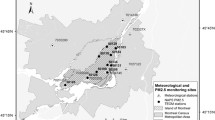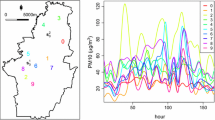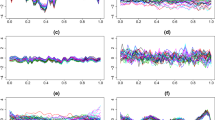Abstract
Functional data featured by a spatial dependence structure occur in many environmental sciences when curves are observed, for example, along time or along depth. Recently, some methods allowing for the prediction of a curve at an unmonitored site have been developed. However, the existing methods do not allow to include in a model exogenous variables that, for example, bring meteorology information in modeling air pollutant concentrations. In order to introduce exogenous variables, potentially observed as curves as well, we propose to extend the so-called kriging with external drift—or regression kriging—to the case of functional data by means of a three-step procedure involving functional modeling for the trend and spatial interpolation of functional residuals. A cross-validation analysis allows to choose smoothing parameters and a preferable kriging predictor for the functional residuals. Our case study considers daily PM10 concentrations measured from October 2005 to March 2006 by the monitoring network of Piemonte region (Italy), with the trend defined by meteorological time-varying covariates and orographical constant-in-time variables. The performance of the proposed methodology is evaluated by predicting PM10 concentration curves on 10 validation sites, even with simulated realistic datasets on a larger number of spatial sites. In this application the proposed methodology represents an alternative to spatio-temporal modeling but it can be applied more generally to spatially dependent functional data whose domain is not a time interval.









Similar content being viewed by others
Notes
The European Environmental Agency has designated 2013 as the Year of Air (see http://www.eea.europa.eu/highlights/2013-kicking-off-the-2018year).
Note that when we apply CTKFD and FKTM to the whole dataset (24 sites for fitting and 10 sites for validation) in Sect. 3.3 this kind of numerical problems does not occur.
References
Caballero W, Giraldo R, Mateu J (2013) A universal kriging approach for spatial functional data. Stoch Environ Res Risk Assess doi:10.1007/s00477-013-0691-4.
Cameletti M, Ignaccolo R, Bande S (2011) Comparing spatio-temporal models for particulate matter in Piemonte. Environmetrics 22:985–996
Cameletti M, Lindgren F, Simpson D, Rue H (2012) Spatio-temporal modeling of particulate matter concentration through the SPDE approach. AStA Adv Stat Anal 97(2):109–131
Crujeiras RM, Van Keilegom I (2010) Least squares estimation of nonlinear spatial trends. Comput Stat Data Anal 54:452–465
Delicado P, Giraldo R, Comas, C, Mateu J (2010) Statistics for spatial functional data: some recent contributions. Environmentrics 21:224–239
EEA (2012) Air quality in Europe 2012 report. Report No 4/2012. European Environment Agency, Copenhagen.
Ferraty F, Laksaci A, Tadj A, Vieu P (2011) Kernel regression with functional response. Electron J Stat 5:150–171
Ferraty F, Vieu P (2006) Nonparametric functional data analysis: theory and practice. Springer, New York.
Finardi S, DeMaria R, D’Allura A, Cascone C, Calori G, Lollobrigida F (2008) A deterministic air quality forecasting system for Torino urban area, Italy. Environ Model Softw 23(3):344–355
Giraldo R, Delicado P, Mateu J (2009) Geostatistics with infinite dimensional data: a generalization of cokriging and multivariable spatial prediction. Reporte Interno de Investigacion No. 14, Universidad Nacional de Colombia
Giraldo R, Delicado P, Mateu J (2010) Continuous time-varying kriging for spatial prediction of functional data: an environmental application. J Agric Biol Environ Stat 15(1):66–82
Giraldo R, Mateu J, Delicado P (2012) geofd: an R package for function-valued geostatistical prediction. Revista Colombiana de Estadstica 35(3):383–405
Giraldo R, Delicado P, Mateu J (2011) Ordinary kriging for function-valued spatial data. Environ Ecol Stat 18(3):411–426
Gromenko O, Kokoszka P (2013) Nonparametric inference in small data sets of spatially indexed curves with application to ionospheric trend determination. Comput Stat Data Anal 59:82–94
Hengl T, Heuvelink GBM, Rossiter DG (2007) About regression-kriging: from equations to case studies. Comput Geosci 33(10):1301–1315
Horváth L, Kokoszka P (2012) Inference for functional data with applications. Springer, New York.
Ivanescu AE, Staicu AM, Greven S, Scheipl F, Crainiceanu CM (2012) Penalized function-on-function regression (April 2012). Dept. of Biostatistics Working Papers, Johns Hopkins University, Working Paper 240. Available at http://biostats.bepress.com/jhubiostat/paper240
Kokoszka P (2012) Dependent functional data. ISRN Probab Stat 1–30. doi:10.5402/2012/958254.
Lahiri SN, Leea Y, Cressie N (2002) On asymptotic distribution and asymptotic efficiency of least squares estimators of spatial variogram parameters. J Stat Plan Inference 103:65–85
Molnar S (1985) On the convergence of the kriging method. Annales Univ Sci Budapest Sect Comput 6:81–90
Nerini D, Monestiez P, Mantè C (2010) Cokriging for spatial functional data. J Multivar Anal 101:409–418
Pebesma EJ (2004) Multivariable geostatistics in S: the gstat package. Comput Geosci 30:683–691
Poli A, Cirillo M (1993) On the use of the normalized mean square error in evaluating dispersion model performance. Atmos Environ 27:2427–2434
R Development Core Team (2012) R: a language and environment for statistical computing. R Foundation for Statistical Computing, Vienna. http://www.R-project.org.
Ramsay JO, Silverman BW (2002) Applied functional data analysis. Springer, New York.
Ramsay JO, Silverman BW (2005) Functional data analysis. Springer, New York.
Ramsay JO, Hooker G, Graves S (2009) Functional data analysis with R and Matlab. Springer, New York.
Ramsay JO, Wickham H, Graves S, Hooker G (2012) FDA: functional data analysis, R package version 2.3.2.
Ruiz-Medina MD, Fernández-Pascual R (2010) Spatiotemporal filtering from fractal spatial functional data sequence. Stoch Environ Res Risk Assess 24:527–538
Ruiz-Medina MD, Salmerón R (2010) Functional maximum-likelihood estimation of arh(p) models. Stoch Environ Res Risk Assess 24:131146.
Ruiz-Medina MD (2012) New challenges in spatial and spatiotemporal functional statistics for high-dimensional data. Spat Stat 1:82–91
Sakata S, Ashida F, Tanaka H (2010) Stabilization of parameter estimation for kriging-based approximation with empirical semivariogram. Comput Methods Appl Mech Eng 199:1710–1721
Salmerón R, Ruiz-Medina MD (2009) Multi-spectral decomposition of functional autoregressive models. Stoch Environ Res Risk Assess 23(3):289–297
Temiyasathit C, Kim SB, Park SK (2009) Spatial prediction of ozone concentration profiles. Comput Stat Data Anal 53:3892–3906
Vazquez E, Bect J (2010) Pointwise consistency of the kriging predictor with known mean and covariance functions. In mODa 9 advances in model-oriented design and analysis. Contributions to statistics, pp 221–228.
Ver Hoef J, Cressie N (1993) Multivariable spatial prediction. Math Geol 25(2):219–240
Wackernagel H (1995) Multivariable geostatistics: an introduction with applications. Springer, Berlin.
Wood SN (2004) Stable and efficient multiple smoothing parameter estimation for generalized additive models. J Am Stat Assoc 99:673–686
Wood SN (2011) Fast stable restricted maximum likelihood and marginal likelihood estimation of semiparametric generalized linear models. J R Stat Soc B 73(1):3–36
Wood SN (2012a) mgcv: mixed GAM computation vehicle with GCV/AIC/REML smoothness estimation, R package version 1.7-22
Wood SN (2012b) On p-values for smooth components of an extended generalized additive model. Biometrika 1–8. doi:10.1093/biomet/ass048.
Yu S, Eder B, Dennis R, Chu S, Schwartz S (2006) New unbiased symmetric metrics for evaluation of air quality models. Atmos Sci Lett 7:26–34
Zhang X, Zheng Y (2012) A note on spatial-temporal lattice modeling and maximum likelihood estimation. Stat Probab Lett 82:2145–2155
Acknowledgments
The authors are grateful to the Associate Editor and two anonymous referees whose comments and suggestions improved the reading and quality of the manuscript. Rosaria Ignaccolo’s work was partially supported by Regione Piemonte and FIRB 2012 Grant (project no. RBFR12URQJ) provided by the Italian Ministry of Education, Universities and Research. This research was also supported in part by the Spanish Ministry of Education and Science and Bancaja through Grants MTM2010-14961 and P1-1B2012-52.
Author information
Authors and Affiliations
Corresponding author
Rights and permissions
About this article
Cite this article
Ignaccolo, R., Mateu, J. & Giraldo, R. Kriging with external drift for functional data for air quality monitoring. Stoch Environ Res Risk Assess 28, 1171–1186 (2014). https://doi.org/10.1007/s00477-013-0806-y
Published:
Issue Date:
DOI: https://doi.org/10.1007/s00477-013-0806-y




